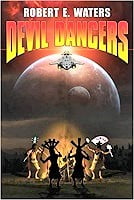by
Robert E. Waters
(eSpec Books, November 2019, pb, 207 pp.)
Reviewed by Victoria Silverwolf
All the stories in this collection relate the adventures of Victorio Nantan, an Apache space pilot leading others of his people into battle against aliens known as the Gulo. For more than thirty years, humans and Gulos raged a brutal war for control of the galaxy. Now the conflict is reaching a climax, as Victorio fights for his own life, those of his companions, and all of humanity. The tales blend military science fiction, space opera, and Apache spiritualism.
“Devil Dancers” introduces the reader to Victorio, his brother Naiche, and the other pilots. After celebrating a recent victory, they accept the challenge of facing the most feared Gulo warrior. Naiche dies in battle. Victorio returns to Earth to mourn, has a vision during a ritual dance, and returns to space to fight his brother’s killer.
The author efficiently establishes the characters, the background, and the way in which Apache traditions add a touch of fantasy to the stories. Some readers may be disappointed by the fact that Naiche’s death occurs offstage, between sections of the narrative.
“Child of the Water” begins with two boys undergoing difficult challenges as part of their training to be warriors. Later, as a fresh recruit under Victorio’s command, one disobeys orders during battle, saving the fleet but leading to the death of the other newcomer. Victorio and his pilots debate whether the young man’s action was foolish or heroic. After having a vision, the recruit returns to the war, determined to atone for the loss of his friend and rival.
The plot demonstrates the importance of both discipline and initiative, as well as accepting the consequences of one’s decisions. This serious theme gives the story more depth than others in the collection. The two battle scenes, like many in this book, seem repetitious.
In “The Sorrow Sea,” Victorio faces a human enemy. An Apache space pirate, formerly a fellow pilot, attacks human ships, hoping to bring an end to what he sees as an immoral war. Their fight to the death involves space battles, Apache magic, and hand-to-hand combat. The story is a gruesome one, made more so by the fact, mentioned in other stories, that the human warriors collect Gulo pelts as trophies. This makes it hard to see either side as sympathetic.
“I Give My Heart to the Hawks” features technology that allows human minds to enter the bodies of hawks, used as spies on Gulo facilities. Victorio does not realize that his commander intends to sacrifice the birds in an attack on the aliens. Allowing this to happen would violate a solemn promise he made to his lover, ending their relationship. Saving the birds would be an act of mutiny, threatening his career.
The premise, as well as Victorio’s crisis of conscience, makes this story one of the more interesting ones in the book. The resolution of the hero’s dilemma is, perhaps, a bit too easy.
“I Am the Lightning” is the longest story in the collection. Victorio’s lover, a fellow pilot, is captured during battle. While a prisoner, she speaks with a pregnant Gulo. The alien desires peace, but reveals that her people will fight to the end to defend their home world. Victorio leads a desperate mission to rescue the woman he loves and her fellow prisoners of war.
This story is notable for the fact that it is the only one with a sympathetic Gulo character. Throughout the rest of the collection, they are only worthy of slaughter. The plot is full of fast-moving battle scenes that will satisfy readers looking for intense military action.
In “The First Peace,” Victorio must again face an enemy other than a Gulo. In this case, it is a robot with artificial intelligence based on his own mind. The robot, intended as a war machine to fight the aliens, instead attacks human vessels. Victorio faces the robot aboard the ship it commands, using both words and action to defeat it.
The premise of this story is similar to that of “The Sorrow Sea,” although different enough to offer something new. A scene where Victorio teaches the robot to perform a ritual dance is unintentionally humorous.
The final story is “Medicine Man.” Victorio’s lover, severely injured in battle and expected to die, returns to Earth in a coma, barely alive. An Apache healer does everything he can to revive her, but only at a terrible cost.
This story demonstrates the author’s knowledge of, and respect for, Apache culture. Even among other tales full of Native American magic, the climax may strain the reader’s suspension of disbelief.
Victoria Silverwolf has some Native American ancestors, but not Apache.
 Devil Dancers and Other Tales
Devil Dancers and Other Tales